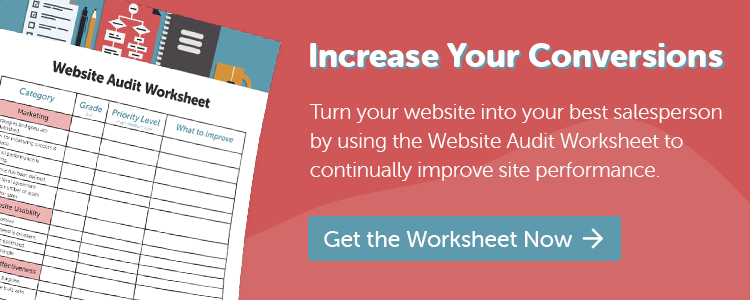Digital marketing auditing is a broad topic and covers a lot of ground – everything from SEO and lead generation to content auditing, social presence, and email auditing – the list goes on and on.
But at the end of the day, it all boils down to one thing: User experience (UX).
The reason these are all important to your website and brand is because each variable plays a small (but significant) role in your user experience. These will determine whether a visitor eventually decides to become a lead or a permanent bounce.
To keep this short and simple, I’ll be focusing on UX auditing. What does it mean to audit a website for its user experience?
And, how does that help you close more deals?
The Importance of Experience
Let’s imagine you’re at a tradeshow and you’re surrounded by hundreds of vendors that are pretty much selling similar products/services. The moment you walk in you’re faced with three different vendors that are trying to get your attention (similar to a search engine results page).
However, of the three, there’s one that you’re fairly familiar with, whereas you’ve never heard of the other two. Who do you go to?
I think the answer is obviously the one you know. But why?
Again, it's about the experience. Now, that experience may not be something that you’ve personally had. It could have been someone else who told you about their experience that made you want to have a similar experience. Hence, you choose the familiar vendor and assume the other was probably a knock-off brand.
The “Human Attention Span”
Now that we understand the importance of experience, let’s talk a little about the “human attention span.”
Let’s imagine you got pulled over by another vendor at a trade show, assuming this company is in the IT (Information Technology) space. They introduce themselves and start telling you about how great their product/service is. They use words such as “unparralled security, superior IT solutions, voted #1 last year for….”, and the list goes on and on.
After about 2 minutes of suffering through this sales pitch, you’re already trying to figure out a way to escape… but politely (or maybe not even politely).
Now think of that same sales pitch on a website being pitched to a random visitor. Odds are, that visitor would leave twice as fast.
Why?
Prospects visit your website to educate themselves about how your products/services could resolve their pain points, not just your accomplishments. It's important to get to the point and tell them what you do, how you do it, and how it's going to help them. They should be guided to this information within the first few minutes of landing on your website.
If they can't find this information quickly, they'll most likely leave and never return. In the end, you've failed to capture their attention and keep them interested in your business.
This is why conducting regular website audits are important. You should make sure your user experience is top-notch and tells visitors exactly what they need to know. But, there are a lot of factors to consider during an audit that directly relate to a user's experience.
Here are nine things you should keep in mind when auditing your website to improve the user experience.
What to Look for When Auditing a Website

1. Your Top Website Pages
When auditing your website, you want to choose the top 10 website pages that are closely aligned to your goal of converting visitors to leads. These are usually your service pages and your conversion pages.
2. Your Top Entrance Pages
You should compare your top "Website Pages" to your top "Entrance Pages". Your top Entrance Pages are usually the pages visitors first land on organically. You can easily do a comparison with tools such as Google Analytics, HubSpot Analytics, etc. In most cases, you’ll find that blogs tend to fill up that list quickly. That’s when you’ll want to switch gears a little and maybe divide your top entrance pages from your top blog posts.
You'll probably begin to notice that the list doesn’t always match up. But that’s okay.
Here's an additional resource to learn about using analytics to audit your website page
3. Where Your Visitors Are Going
Your next step is to pull up your Google Flowchart (or something similar) to see where your website visitors are going after they’ve landed on an entrance page. Another tool you should also have at your disposal is a heat mapping tool like Hotjar. This will give you an actual recording of how users are interacting with your pages.
Once you have a better idea of how users are interacting with your pages, ask yourself: “Is my website easy to comprehend? Am I’m creating/giving the user the best journey possible?”
4. Messaging
Is your initial messaging on your website clear? If a visitor lands on your page, how long would it take them to figure out what exactly you do?
Now keep in mind, you’re not writing this for yourself or for a coworker. Making the assumption that it’s fairly obvious what you do is, by far, the most common mistake I see businesses make.
Additionally, if you’re a HubSpot user, then taking advantage of smart content should come naturally. This will help to ensure that your messaging is directed toward your visitors no matter what stage of the buyer's journey they're in.
5. What You Do VS. How You Do It
This is another common issue I’ve seen. Explaining to someone what you do doesn’t always explain how you do it. Think of the “How It Works” or “ Our Process” message as adding the human touch to your product/service.
Having a clear explanation of your process tends to allow users to visualize how that product or service can actually affect their lives in a positive manner.
For example, if you’re a staffing agency with a focus on partnering with B2B companies in an effort to get them more qualified candidates, then explaining what that process looks like is important for letting them know they can trust you to fulfill their needs.
6. Differentiators
Today, almost every product/service has a competitor that is doing/selling something very similar. As a result, you’ll notice that you and your competitors have very similar services.
This is where you’ll want to highlight what makes you different.
If you offer eight different services, clearly you’ll want to speak about all of them. However, you really want to highlight the two or three services that set you apart from the rest of your industry and make your company unique.
7. Conversion Opportunities
If, after looking through your heat mapping tool on your service pages, you realized your next steps are too far down on the journey, consider adding a link that would quickly get the user to that next step.
Keep in mind that you should have already clearly identified your Top of the Funnel (TOFU), Middle of the Funnel (MOFU) and Bottom of the Funnel (BOFU) pages to ensure your next steps are clear.
8. Pricing

There are a few companies that refuses to put a pricing page on their website because they don’t want their competitors to know how much they are charging for each service/product. Pricing is important for customers to know before making that final decision in most industries. Keep in mind, prospect would rather do their own research as oppose to a sales pitch.
However, if you’re in one of those niche industries where pricing is meant almost as a "trade secret", try to ensure that you make it very easy for a prospect to contact you to get that information.
9. A/B Testing
Sometimes, while auditing your website, you’ll find that you and your team might have multiple ideas and may not know which is more likely to work. This is where you’d want to A/B test different designs to see which is the best user experience that meets your goals.
All in all, never assume that anyone who visits your website knows what you do and your process. As for the visitors that are already familiar with your industry, ensure your process and differentiators are clear – as that might be the deciding factor.
Auditing your website is essential to monitoring the health of your website and marketing efforts. This should be done strategically and, if possible, quarterly. That way, you'll always have an optimized website to attract new visitors and provide them with the information they need – and want – to convince them you're the best choice for the job.


Karey Mitchell
I've been with Bluleadz since 2016. I work closely with our marketing/sales team to brainstorm marketing strategies to make everything look pixel-perfect. I’m a curious person at heart and jump to every opportunity to learn something new or take on a challenge.